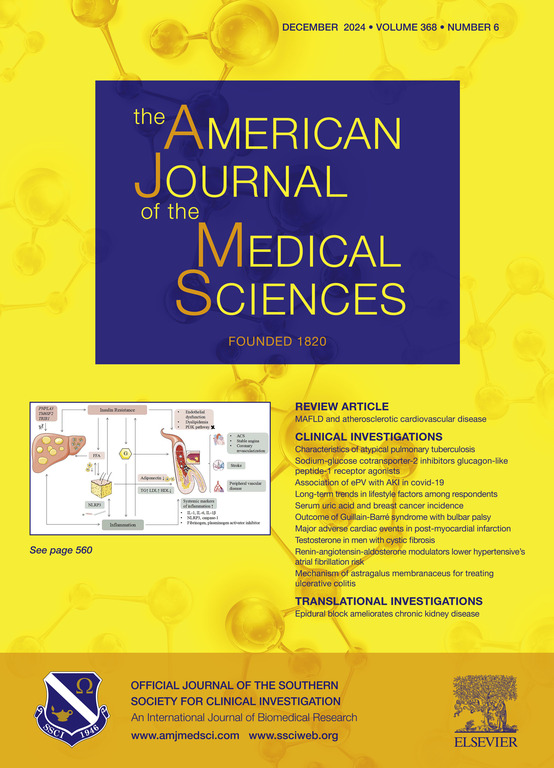The expression and clinical significance of cytokines Th1, Th2, and Th17 in ovarian cancer
IF 2.3
4区 医学
Q2 MEDICINE, GENERAL & INTERNAL
引用次数: 0
Abstract
Background
This study was to analyze the levels of Th1, Th2 and Th17 cytokines in peripheral blood samples from ovarian cancer (OC) patients.
Methods
Ninty-five OC patients including 45 OC and 50 benign ovarian disease (BOD) were selected at Zhejiang Cancer Hospital from October 2021 to March 2022; 46 healthy participants were simultaneously selected at Taizhou Municipal Hospital as healthy controls (HC). The expressions of Th1, Th2 and Th17 were compared in all participants. Marker levels were analyzed with age, histological type, tumor size, ovarian number and clinical stage of OC.
Results
The IL6 and IL8 levels were significantly higher in OC compared to BOD and HC (p < 0.00). The IL-4 expression was significantly higher in OC compared to HC (p < 0.00). The expressions of IL2, IL6 and IL10 were significantly higher in pathological stage III-IV OC compared with pathological stage I-II OC (p < 0.05). Meanwhile, the levels of IL-2 and IL-10 were significantly higher in OC with bilateral ovaries than in OC with single ovary (p < 0.05). AUCs of different markers were to diagnose OC. The findings also implied that the expressions of IL-6, IL-8 and IL-10 were significantly different between OC and control groups (p < 0.05), while the levels of IL-2, IL-4, TNF-α, IFN-γ, IL-12p70, IL-1β and IL-5 between the two groups were not different (p > 0.05).
Conclusions
In peripheral blood from OC patients, the immune system was more dysregulated and immune cells produced more cytokines with contrasting actions. These data showed significant clinical implications for the diagnosis of OC.
细胞因子 Th1、Th2 和 Th17 在卵巢癌中的表达及其临床意义。
背景:本研究旨在分析卵巢癌(OC)患者外周血样本中 Th1、Th2 和 Th17 细胞因子的水平:本研究旨在分析卵巢癌(OC)患者外周血样本中Th1、Th2和Th17细胞因子的水平:方法:选取2021年10月至2022年3月浙江省肿瘤医院收治的95例卵巢癌患者作为研究对象,其中包括45例卵巢癌患者和50例良性卵巢病(BOD)患者;同时选取台州市立医院收治的46例健康人作为健康对照(HC)。比较了所有参与者中 Th1、Th2 和 Th17 的表达。标记物水平与OC的年龄、组织学类型、肿瘤大小、卵巢数量和临床分期有关:结果:与 BOD 和 HC 相比,OC 的 IL6 和 IL8 水平明显更高(P 0.05):结论:在 OC 患者的外周血中,免疫系统更加失调,免疫细胞产生了更多具有相反作用的细胞因子。这些数据对 OC 的诊断具有重要的临床意义。
本文章由计算机程序翻译,如有差异,请以英文原文为准。
求助全文
约1分钟内获得全文
求助全文
来源期刊
CiteScore
4.40
自引率
0.00%
发文量
303
审稿时长
1.5 months
期刊介绍:
The American Journal of The Medical Sciences (AJMS), founded in 1820, is the 2nd oldest medical journal in the United States. The AJMS is the official journal of the Southern Society for Clinical Investigation (SSCI). The SSCI is dedicated to the advancement of medical research and the exchange of knowledge, information and ideas. Its members are committed to mentoring future generations of medical investigators and promoting careers in academic medicine. The AJMS publishes, on a monthly basis, peer-reviewed articles in the field of internal medicine and its subspecialties, which include:
Original clinical and basic science investigations
Review articles
Online Images in the Medical Sciences
Special Features Include:
Patient-Centered Focused Reviews
History of Medicine
The Science of Medical Education.

 求助内容:
求助内容: 应助结果提醒方式:
应助结果提醒方式:


